
|
|
PRINT » |
|
|
E-MAIL THIS PAGE » |
|
|
CLOSE THIS WINDOW » |
Hyde Estate
Owners of famed Carneros vineyard bolster brand with new winery
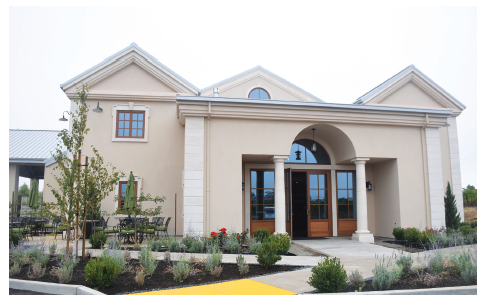 Well after Hyde Vineyards had become an established farming operation with dozens of high-end winery clients producing vineyard-designate wines and a waiting list of other premium wineries hoping to do the same, founder Larry Hyde purchased another property in the Carneros appellation of Napa County.
Well after Hyde Vineyards had become an established farming operation with dozens of high-end winery clients producing vineyard-designate wines and a waiting list of other premium wineries hoping to do the same, founder Larry Hyde purchased another property in the Carneros appellation of Napa County.
On the north side of Highway 12, which runs from Napa to Sonoma, Hyde Vineyards included more than 150 acres of vines that Hyde had established in 1979; on the south side of the highway was a parcel of about 30 acres he had purchased in 2005.
The larger, more famous vineyard operation was owned by Larry Hyde and other members of the Hyde family, but the smaller plot was for him and his sons and would eventually support a small wine brand.
Beginning with the 2017 vintage, that wine brand is being produced in a new winery, and Hyde owns the vineyards on both sides of Highway 12.
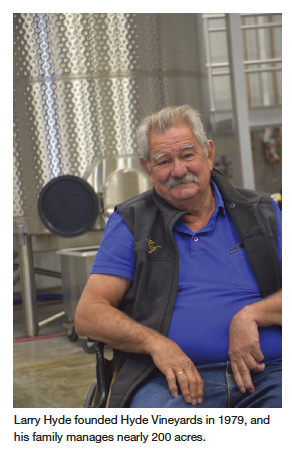 Larry Hyde and his sons now manage nearly 200 acres of vineyards in Carneros. The new winery is surrounded by the vines that Larry Hyde, 72, and sons Peter, 33, and Chris, 31, planted in 2006. Wines produced at the winery are bottled under the Larry Hyde brand, and the winery is called Hyde Estate. Larry and his wife, Beta, are partners with Peter and Chris in Hyde Vineyards and the new winery, but the two entities are managed as separate companies with Chris Hyde serving as managing partner of the winery.
Larry Hyde and his sons now manage nearly 200 acres of vineyards in Carneros. The new winery is surrounded by the vines that Larry Hyde, 72, and sons Peter, 33, and Chris, 31, planted in 2006. Wines produced at the winery are bottled under the Larry Hyde brand, and the winery is called Hyde Estate. Larry and his wife, Beta, are partners with Peter and Chris in Hyde Vineyards and the new winery, but the two entities are managed as separate companies with Chris Hyde serving as managing partner of the winery.
As the stainless steel catwalks were being installed in late August, just in time for the first pick of Pinot Noir, Larry Hyde sat in the new winery tasting room and discussed the impetus for the new winery. “One way we got here was Christopher passed his masters’ program in wine business and became aware of the financial potential of producing your own wines,” he said.
While a wine brand and winery had been part of the original vision of purchasing the new property, it’s still a much smaller business when compared to the vineyard. “That’s our primary business: selling grapes to good wineries, and that still pays for everything,” Larry Hyde said.
Several years before the winery was built, Hyde and his sons put together a deal to buy out Hyde Vineyards. That deal closed in 2011, and a few years later, when Chris Hyde was earning his MBA at Sonoma State University, he began to evaluate the family’s small wine business. Prior to his studies at Sonoma State, Chris Hyde earned a bachelor’s degree in agricultural business from California Polytechnic State University in San Luis Obispo and worked at the sales and marketing firm Wilson Daniels and the Carneros winery Starmont.
In addition to the vineyards and winery, the Hydes are partners in Hyde de Villaine, or HdV, which is a collaboration between them and Aubert de Villaine, co-owner and co-director of the famed Burgundy estate Domaine de la Romanée-Conti and owner of A & P de Villaine. Aubert de Villaine married Larry Hyde’s cousin, Pamela Fairbanks. Chris Hyde is HDV’s director of viticulture as well as general manager at Hyde Vineyards.
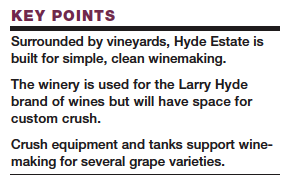 While the Hydes had always made a barrel or two of wine from their grapes, it wasn’t a commercial project until 2009, when they bottled Pinot Noir under the brand Larry Hyde & Sons. That wine was made at the Patz & Hall winery in Sonoma, where Peter Hyde was working in the cellar.
While the Hydes had always made a barrel or two of wine from their grapes, it wasn’t a commercial project until 2009, when they bottled Pinot Noir under the brand Larry Hyde & Sons. That wine was made at the Patz & Hall winery in Sonoma, where Peter Hyde was working in the cellar.
Winemaker and co-founder James Hall had been a longtime client of Hyde Vineyards, and when the Hydes had some grapes from their new property available, they offered them to Hall. But because the grapes wouldn’t be from Hyde Vineyards, Hall had to decline yet encouraged the Hydes to make their own wine. “We had all this new fruit that we had the opportunity to make into wine, and James said, ‘Why don’t you bring it over and crush it?’” Chris Hyde recalled.
That brand was the first separate entity by Larry Hyde and his immediate family, and it helped pave the way for their buyout of Hyde Vineyards and now the new winery.
Years earlier, Hall, who was working as the winemaker at Honig Vineyards in Napa Valley, had launched his own brand in 1988 with partner Donald Patz. Hall recounted that his first vintage working with Hyde Vineyards grapes was in 1990, when a wet spring resulted in the vineyard being his only source of Chardonnay. While he could have made that wine a vineyard designate, Hall instead labeled it a Napa Valley Chardonnay, but it still did quite well.
“Robert Parker loved it and gave us a brilliant review on the back cover of the Wine Advocate,” he told Wines & Vines. “Our New York distributor, Lauber Imports, purchased all of the remaining stock within two weeks of the review. In fact, this purchase kept the winery solvent.”
In addition to it providing the commercial success that kept his young wine company afloat, Hall still considers the 1990 Chardonnay from Hyde Vineyards one of the finest wines he has ever made. He calls it “a great year, and the vineyard was just hitting its stride.”
That wine helped establish Patz & Hall as a brand, and when Hall started regularly producing a Hyde Vineyards designate, it helped the winery enjoy consistently high reviews and strong sales that eventually led to the company’s 2016 acquisition by Ste. Michelle Wine Estates of Woodinville, Wash.
As Chris Hyde worked on plans for the new winery and wine business, Hall offered his expertise as an informal consultant. “Honestly, James Hall was a big influence on me. I spent a lot of time talking to him about the opportunities and what it takes to run a winery. I think he started Patz & Hall when he was around my age,” he said.
The Patz & Hall influence runs deep at the new Hyde Estate winery. Hall first met Hyde winemaker Alberto Rodriguez in 1991, when Rodriguez was a teenager working in the vineyards.
Hall remembers him as a young kid who came by the winery after picking was done and started asking what they were still doing working in the winery. Hall told him they’d be pressing grapes until midnight, and Rodriguez offered to help. Because the teen had no cellar experience, Hall declined the offer, but four days later Rodriguez was back, and when he saw the winemaking team was going to be working late again, he offered his help once more. Hall conceded he needed the help, and so he hired Rodriguez. “He literally talked his way into a winemaking job,” Hall said.
That evening launched a winemaking career that eventually led to Rodriguez being named winemaker at Keller Estate. In 2012, Rodriguez left Keller and took a step down to become assistant winemaker at Patz & Hall, so he could rejoin his mentor. While at Patz & Hall, Rodriguez helped manage all custom-crush clients, and that included Larry Hyde’s brand.
When Rodriguez learned the Hydes were looking for a winemaker, “This opportunity came up, and I just jumped for it.” Already familiar with the grapes and the owners, Rodriguez joined the Hyde winery in May 2017.
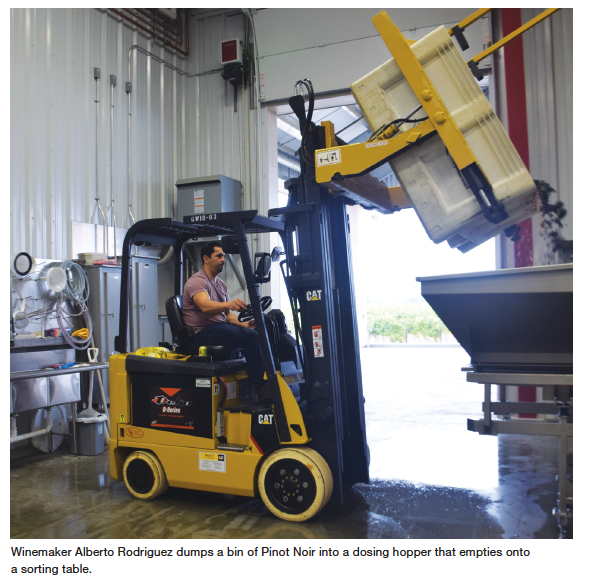 Wine production
Wine production
Rodriguez has a variety of tanks in the cellar ranging from three closed-top La Grande tanks to open-top tanks from Santa Rosa Stainless Steel and Westec. Pinot Noir ferments in the open-tops, while everything else ferments in the closed-top tanks.
In general, Rodriguez said the winemaking style at Hyde Estate is simple. Rodriguez makes the picking decisions and said he works closely with vineyard manager Jose Padilla, who has worked for Hyde Vineyards since 1979.
The grapes are all harvested by hand (Hyde Vineyards has a full time crew of vineyard workers) and brought to the winery in half-ton MacroBins hauled by tractor. “Usually our fruit comes in pretty clean,” Rodriguez said. “We’re happy we have our vineyard crew, and they’re paying attention to our blocks, so we’ll just pull any leaves or anything we don’t want.”
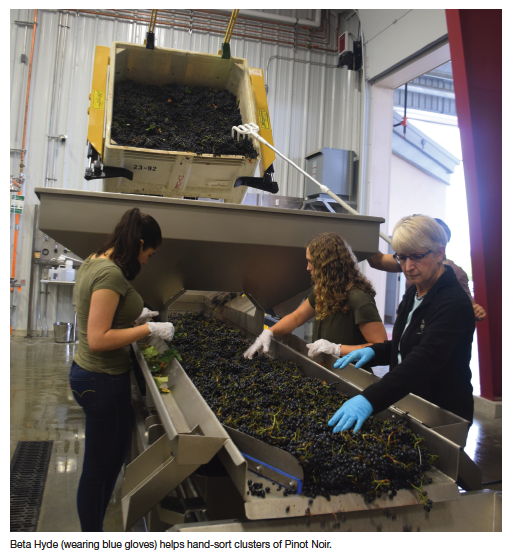 Bins are dumped into the dosing hopper of a Euro-Machines vibratory table that transfers grapes to an elevated conveyor also by Euro-Machines that feeds an Armbruster Rotovib destemmer. Rodriguez said many other Pinot wineries are buying the latest generation of the Rotovib because of its multiple axes of movement, gentle action and multiple speed settings. Destemmed berries are collected in MacroBins and then dumped into the open-top tanks.
Bins are dumped into the dosing hopper of a Euro-Machines vibratory table that transfers grapes to an elevated conveyor also by Euro-Machines that feeds an Armbruster Rotovib destemmer. Rodriguez said many other Pinot wineries are buying the latest generation of the Rotovib because of its multiple axes of movement, gentle action and multiple speed settings. Destemmed berries are collected in MacroBins and then dumped into the open-top tanks.
Pinot Noir must goes through a cold soak of a few days before primary fermentation that can last for 10 to 15 days. Rodriguez said he sometimes puts the must through some extended maceration as he tastes for just the right moment to press. “It’s very interesting going through that phase of winemaking, because there are a lot of changes, and you just wait on that press decision,” he said. “It’s the same as when you’re going to pick.”
When the time is just right for pressing, the winery has a P80 Europress that can handle 6 tons of whole clusters or more than 15 tons of fermented must.
Chardonnay grapes go into the press whole cluster, and the juice is then collected into stainless steel tanks or drums for up to 48 hours of settling. The clarified juice is racked off the heavy less and then transferred to barrels for fermentation. All of the Chardonnay is barrel fermented in new Francois Freres barrels, while the Viognier ferments in stainless steel.
The main barrel room, located between the cellar and tasting room, also has a separate, smaller area that can be closed off and warmed if needed. “Hyde has well known high acidity, low pH, so it’s a little of a struggle going through malolactic fermentation (ML),” Rodriguez said. “We created this room so if we have any issues with the ferment or anything that needs to go through ML, we can close the door and keep it a different temperature in here.”
With production also including Syrah and Bordeaux varieties, Rodriguez said he also purchased some barrels by Taransaud and Atelier.
Total production of the Hyde brand is around 2,000 cases, and with a permitted, total capacity of 12,000 cases, the winery will likely host some custom-crush clients in coming years.
The production area also includes a small lab and office that Chris Hyde said were a late addition. The winery equipment pad was going to be on the side of the building near the crush pad, but the area proved too small, so infrastructure such as the glycol system was moved to the rear of the building, where plans had called for employee parking.
The flow of hot and cold glycol for warming and cooling tanks is controlled by a system by Lewis Mechanical in Santa Rosa, Calif. Wolff’s Welding & Fabrication in Napa built the winery catwalks and an overhead rail for a pneumatic punchdown device. Bill Smith, who works for Hyde Vineyards as fabricator and mechanic, also helped build most of the tasting room furniture and the stainless steel fittings board at the winery.
Opening up space on the side of the building allowed for the lab, office and employee restroom. All analysis is currently sent out to ETS Laboratories, but Chris Hyde said the area offers the space for some routine analysis when production has grown enough to warrant some in-house lab work.
Winery design
The Hydes had planned for 2016 to be the inaugural crush for the winery, but rain caused significant construction delays. While not on time, the project did finish on budget, although Chris Hyde declined to state the total cost of the new winery.
George Bachich of Madsen Commercial Building in Napa was the contractor and the architect was San Francisco-based Jerry D. Gere.
Larry Hyde met Gere when building the Hyde de Villane winery in the early 2000s and was happy to use his services for the newest winery. Gere died before the winery was completed,
and the Hydes have some of his original drawings framed and hanging in the tasting room in memoriam.
The exterior and interior designs of the winery were also influenced by Beta Hyde, who sought to give it a look similar to Polish manor houses from the 19th century. Larry and Beta met in Burgundy when they were working in the vineyards of Domaine A. & P. de Villaine in 1980 and 1981. The two later married in Lublin, Poland, in 1983.
Beta Hyde she wasn’t inspired by any one particular manor house but rather the aesthetics and design touches of them in general.
When Larry Hyde purchased the property, it was home to a home and barn from the early 20th century and an old fruit orchard. The first to go was the orchard to make way for Chardonnay and Pinot vineyards, followed by the home when construction of the winery commenced. Chris Hyde said the barn will be restored with as much original lumber as possible. When finished, he said it will be used as a guest house and space for larger, private tastings.
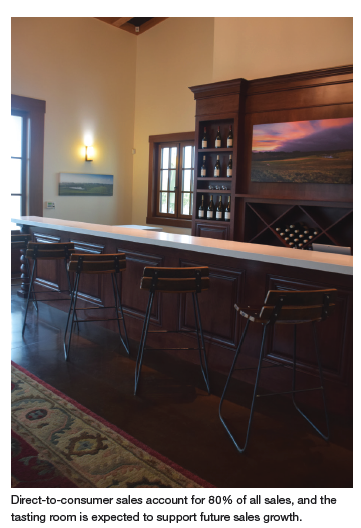 The new tasting room is open by appointment. Tasting room and wine club sales will be two vital pillars for growth, as the business strategy is centered on direct-to-consumer (DtC) sales.
The new tasting room is open by appointment. Tasting room and wine club sales will be two vital pillars for growth, as the business strategy is centered on direct-to-consumer (DtC) sales.
DtC already counts for about 80% of sales volume, with wholesale representation primarily in Los Angeles and San Francisco. The Pinot Noir sells for $65, and the Chardonnay is $55 per bottle.
Production won’t be limited to just the Burgundian varieties, although those will always remain the focus. The lineup will also include Viognier, Syrah, Merlot and possibly Cabernet Sauvignon. Everything other than Pinot and Chardonnay will likely be sold exclusively through the tasting room, Chris Hyde said.
‘Crowning achievement’
Hall described the new winery as “the crowning achievement of a wonderful career.” He said while Larry Hyde may have come from an affluent family, he started his career in the cellar and then committed himself and his life to always improving the vineyard. “Larry had a lot of resources, but he didn’t throw his money around. He worked his ass off and did it the right way,” Hall said. “He dedicated his life to learning about the vineyard.”
He said Larry Hyde was particularly shrewd in dividing the vineyard’s crop among many winemakers who all went on to produce outstanding wines. Those wines from many different wineries did more to demonstrate the quality of the site than if Larry Hyde produced his own wines from the start or sold all the grapes to just one large client. Hall likened it to Pisoni Vineyards in the Santa Lucia Highlands AVA of Monterey County. “When you have competing wineries making great wines, it says something about the site,” Hall said.
As winemaker, Rodriguez has the enviable perk of a reliable source of high-quality grapes, but that also comes with some expectations as the same grapes are used by wineries such as Patz & Hall, Ramey Wine Cellars, DuMOL, Paul Hobbs Winery, Joseph Phelps, Schramsberg Vineyards, Massican Winery and others.
Rodriguez said he’s been working closely with the vineyard manager Padilla to ensure the estate is reflected at the same high level under the Larry Hyde brand. “He knows the importance of making great wines, and I’m the kind of guy who believes the best wines come from the best vineyards,” Rodriguez said. “Eighty percent of a great wine is from the vineyard, and only 20% is the winemaking. I want to put Hyde at the very top, and I’m working with Jose to achieve that.”
It may take a while for the winery to pay all the bills, but Rodriguez has access to an excellent vineyard and a brand-new winery, so he’s got a good shot.
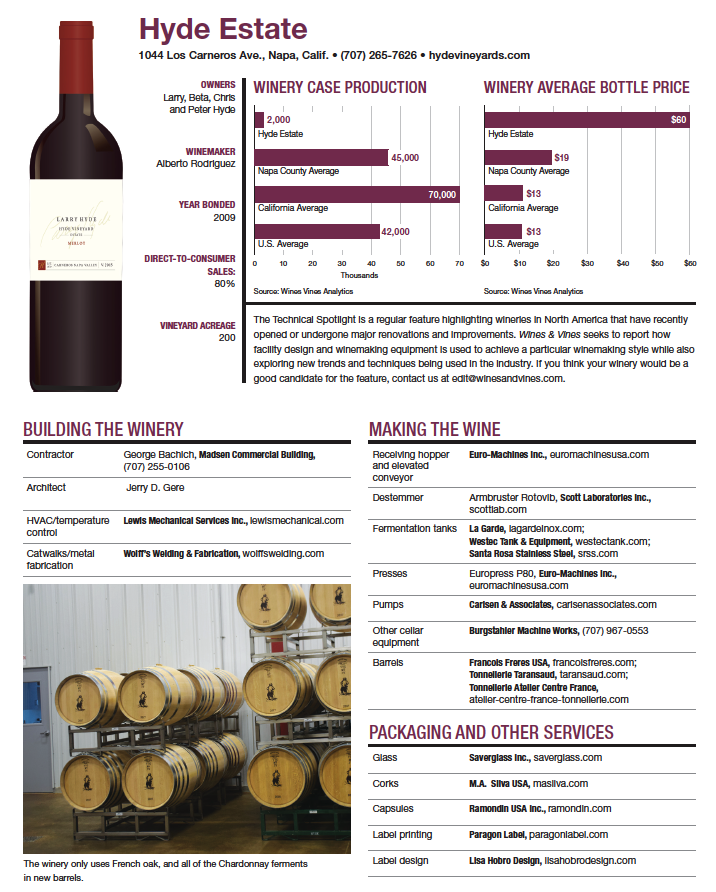
|
|
PRINT » |
|
|
E-MAIL THIS ARTICLE » |
|
|
CLOSE THIS WINDOW » |
